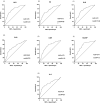Peripheral blood inflammatory markers in predicting prognosis in patients with COVID-19. Some differences with influenza A
- PMID: 33225517
- PMCID: PMC7744870
- DOI: 10.1002/jcla.23657
Peripheral blood inflammatory markers in predicting prognosis in patients with COVID-19. Some differences with influenza A
Abstract
Background: To evaluate the ability of peripheral blood inflammatory markers in predicating the typing of COVID-19, prognosis, and some differences between COVID-19 and influenza A patients.
Methods: Clinical data on 285 cases laboratory-confirmed as SARS-CoV-2 infection were obtained from a Wuhan local hospital's electronic medical records according to previously designed standardized data collection forms. Additional 446 Influenza A outpatients' hematologic data were enrolled for comparison.
Results: NLR, SII, RLR, PLR, HsCRP, and IL-6 were significant higher and LMR was lower in severe COVID-19 patients than in mild COVID-19 patients (p < .001). PLR and LMR were lower in the individuals with influenza A than those with COVID-19 (p < .01). COVID-19 patients with higher levels of NLR, SII, RLR, PLR, HsCRP, and IL-6 and lower LMR were significantly associated with the severe type. AUC of NLR (0.76) was larger while the specificity of IL-6 (86%) and sensitivity of HsCRP (89%) were higher than other inflammatory markers in predicating the typing of COVID-19. PT had obvious correlation with all the inflammatory markers except RPR. NLR showed positive correlations with AST, TP, BUN, CREA, PT, and D-dimer. Patients with high IL-6 levels have a relatively worse prognosis (HR = 2.30).
Conclusion: Peripheral blood inflammatory markers reflected the intensity of inflammation and associated with severity of COVID-19.NLR was more useful to predict severity as well as IL-6 to predict prognosis of COVID-19. PLR and LMR were initially found to be higher in SARS-CoV-2 virus-infected group than in influenza A.
Keywords: COVID-19; SARS-CoV-2; inflammatory markers; influenza A.
© 2020 The Authors. Journal of Clinical Laboratory Analysis Published by Wiley Periodicals LLC.
Conflict of interest statement
The authors disclose no conflicts of interest.
Figures
References
MeSH terms
Substances
LinkOut - more resources
Full Text Sources
Medical
Miscellaneous


